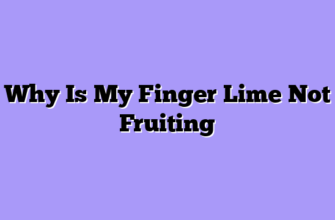When I first stumbled upon Citrus australasica at a specialty fruit growers’ conference, I honestly thought someone was playing a trick on me. These peculiar, elongated fruits looked more like pickles than citrus, and when I cut one open, tiny pearls of tangy juice burst onto my fingers like edible confetti.
That moment changed my farming trajectory forever. Now, as someone who’s dedicated a significant portion of my orchards to these remarkable native Australian bushes, I can tell you that finger limes – or as the Aboriginal peoples call them, “caviar limes” – are among the most fascinating and rewarding crops I’ve ever cultivated.
Understanding the Rainbow: Popular Cultivars and Their Unique Characteristics
The diversity within Citrus australasica varieties never ceases to amaze me. Walking through my groves, I’m surrounded by what feels like nature’s jewelry box, with each cultivar offering something distinctly different. Let me share what I’ve learned about the most popular varieties that thrive here in American soil.
The Alstonville variety was my gateway drug into finger lime cultivation. This cultivar produces burgundy-skinned fruits with vibrant pink vesicles – those caviar-like pearls inside – that literally explode with flavor on your tongue. I remember my first harvest, standing in the orchard at dawn, carefully plucking these three-inch gems and thinking about how chefs would go absolutely wild for them. And they did. My restaurant clients started requesting Alstonville specifically because of its consistent productivity and that gorgeous pink flesh that photographs like a dream on their plates.

The Crimson Tide cultivar produces some of the most visually stunning fruit I’ve ever grown. Picture this: deep red skin concealing ruby-red vesicles that look like tiny garnets. The first time I supplied these to a high-end cocktail bar, the mixologist literally gasped. They’ve since become a signature ingredient in their premium martinis, and I’ve had to expand my Crimson Tide section twice to keep up with demand.
For commercial viability, I can’t ignore the Rainforest Pearl variety. These bushfood plants produce greenish-yellow skinned fruits with lime-green pearls inside – the classic look that most people associate with finger limes. They’re incredibly productive, and the flavor profile hits that perfect balance between tart and slightly sweet that makes them versatile for both sweet and savory applications.
Here’s a comparison table of the varieties I work with most extensively:
| Variety Name | Skin Color | Vesicle Color | Size Range | Harvest Period | Thorniness |
|---|---|---|---|---|---|
| Alstonville | Burgundy-Brown | Pink to Red | 2-3 inches | Fall-Winter | Moderate |
| Judy’s Everbearing | Green-Yellow | Pale Green-Pink | 3-4 inches | Year-round | Minimal |
| Crimson Tide | Dark Red | Ruby Red | 2.5-3 inches | Winter-Spring | Heavy |
| Rainforest Pearl | Green-Yellow | Lime Green | 3-4 inches | Fall-Spring | Moderate |
| Collette | Purple-Black | Pink | 2-3 inches | Winter | Heavy |
Cultivation Secrets: What I’ve Learned the Hard Way
Growing these Australian native lime plants isn’t quite like cultivating regular citrus, and I learned that lesson through some expensive mistakes early on. These microcitrus beauties evolved in the subtropical rainforests of Queensland and New South Wales, which means they have specific preferences you need to respect if you want them to thrive.
First, let’s talk about soil. My biggest rookie error was treating finger limes like standard citrus trees. I planted my first batch in the slightly alkaline soil that my Valencia oranges loved, and watched them struggle for an entire season before I figured out the problem. Citrus australasica demands acidic soil – we’re talking pH levels between 5.5 and 6.5. Once I amended my beds with sulfur and plenty of organic matter, the transformation was remarkable. Within months, my struggling plants burst into vigorous growth.
Water management requires a delicate balance that would frustrate any heavy-handed farmer. These caviar lime bushes hate wet feet – root rot can devastate a crop faster than you can say “microcitrus” – but they also suffer quickly from drought stress. I installed drip irrigation throughout my finger lime sections, which allows me to maintain consistent moisture without waterlogging. During our hot summers, I water deeply twice weekly, but in cooler months, I cut back to once every ten days or so.
The thorniness of many varieties deserves special mention because it significantly impacts harvest labor. Let me paint you a picture: imagine reaching into a dense bush armed with needle-sharp spines, trying to locate and twist off delicate fruits without puncturing them or yourself. It’s like playing Operation with real stakes. I’ve learned to:
- Harvest early morning when fruits are firmest and less likely to burst
- Use thick leather gloves extending past the wrist
- Employ long-sleeved shirts made from tightly woven fabric
- Keep pruning shears handy to access fruits deep within the canopy rather than reaching blindly
- Train new harvest workers on proper technique before turning them loose
- Maintain clear pathways between rows to minimize accidental encounters with thorny branches
Speaking of pruning, these Australian finger limes respond beautifully to thoughtful shaping. I maintain my bushes at about six to eight feet tall, which keeps harvesting manageable and allows better air circulation. This height also helps with pest management – and believe me, these plants can attract their share of problems.
Market Realities and Commercial Potential
Let’s talk money, because that’s what keeps the lights on and the farm running. When I first approached local restaurants with finger limes, most chefs had never heard of them. Now, five growing seasons later, I have a waiting list of buyers, and I’m selling these citrus pearls for anywhere from $30 to $50 per pound wholesale. Retail prices at farmers’ markets? I’ve seen them command $60 to $80 per pound when supply is tight.
The economics work out roughly like this for my operation:
- Initial investment per plant (grafted, two-year-old): $35-$50
- Years until significant production: 3-4 years from planting
- Mature plant yield: 2-6 pounds per year depending on variety and conditions
- Revenue per mature plant annually: $60-$300 wholesale
- Major cost factors: irrigation, pest management, harvest labor, and soil amendments
One of my most successful marketing strategies has been building relationships with high-end restaurants and craft cocktail bars. These establishments love the visual drama of finger limes and are willing to pay premium prices for consistent, quality supply. I also discovered a thriving market among home bakers and jam makers who create artisanal products. A local entrepreneur now makes a finger lime marmalade using my Rainforest Pearl variety that’s become regionally famous.
The specialty food market continues growing, with consumers increasingly seeking unique, exotic flavors. According to data I’ve seen from agricultural extension services, demand for specialty citrus has grown approximately 15-20% annually over recent years. Australian finger limes sit perfectly in this trend, offering both novelty and genuine culinary value.
Challenges and Practical Considerations
I’d be dishonest if I painted finger lime cultivation as all sunshine and profits. These native Australian citrus plants come with legitimate challenges that you need to consider before dedicating valuable orchard space to them.
Pest pressure can be intense. Asian citrus psyllids love finger limes just as much as they love standard citrus, and these insects vector the devastating disease Huanglongbing (citrus greening). I scout my plants weekly during growing season and maintain a strict integrated pest management program. Scale insects also find these plants irresistible, and I’ve spent countless hours with horticultural oil sprayers managing infestations.
Fruit set can be frustratingly inconsistent. Some years my Crimson Tide section produces prolifically; other years, the same plants barely fruit despite seemingly identical conditions. I’ve learned that these bushfood natives are sensitive to temperature fluctuations during flowering. A late cold snap or unseasonably hot spell during bloom can dramatically reduce that season’s harvest.
The narrow harvest window for optimal quality demands careful attention. Unlike storage citrus that can hang on trees for months, finger limes have a sweet spot of maybe two to three weeks when they’re perfect. Harvest too early, and the vesicles haven’t developed full flavor. Wait too long, and the fruits begin dropping or the skin toughens. I walk my rows every few days during harvest season, checking for that subtle color change that signals peak ripeness.
Here’s a reality check on what affects your success with these caviar limes:
| Success Factor | Impact Level | My Solutions |
|---|---|---|
| Soil pH Management | Critical | Regular testing, sulfur amendments, mulching |
| Irrigation Consistency | Critical | Drip system with timers, moisture monitoring |
| Pest Monitoring | High | Weekly scouting, IPM protocols, beneficial insects |
| Harvest Timing | High | Daily walks during season, color charts, experience |
| Frost Protection | Moderate-High | Row covers, location selection, microclimates |
| Pruning Knowledge | Moderate | Annual training, maintaining productive shape |
The Future Looks Bright (and Tart)
Standing in my orchards today, watching the morning light catch the dew on emerging finger lime flowers, I feel incredibly optimistic about the future of Citrus australasica cultivation in America. We’re still in the early adoption phase, which means opportunities abound for growers willing to learn these plants’ quirks and meet the market’s growing appetite for unique flavors.
The culinary world’s embrace of finger limes continues accelerating. What started as a haute cuisine garnish has expanded into mainstream applications. I’ve seen my citrus pearls appear in everything from seafood tacos to chocolate desserts, from gin cocktails to ceviche. Each new application opens additional market channels.
Climate change, ironically, might favor finger lime cultivation in some regions. As traditional citrus-growing areas face increasing challenges from diseases and weather extremes, these hardy native Australian plants – evolved to handle variable conditions – may prove more resilient. They tolerate marginal soils better than standard citrus and can produce in areas where traditional varieties struggle.
I’m also excited about ongoing breeding work. Nurseries are developing new cultivars with improved characteristics: better cold hardiness, reduced thorniness, unique color combinations, and enhanced disease resistance. The variety Rainbow Bliss recently caught my attention – it supposedly produces vesicles that change color from green to pink to red within the same fruit. I’ve got several on order for trial planting.
For farmers considering whether to venture into finger lime cultivation, I’d ask: Are you patient? These aren’t annual crops that pay back quickly. Are you detail-oriented? These plants demand attentive management. Do you have access to high-value markets? Finger limes aren’t commodity crops you’ll sell by the truckload to processors.
But if you can answer yes to those questions, and you’re excited by the prospect of growing something truly special – something that makes chefs’ eyes light up and diners take photos before they eat – then Australian finger limes might be your perfect niche. They’ve certainly been mine.
Every time I slice open a perfectly ripe Crimson Tide or Alstonville and those jewel-like vesicles tumble out, I’m reminded why I love this work. These peculiar fruits, evolved in distant Australian rainforests, now thrive in my American soil, connecting me to a global community of growers, chefs, and food lovers. That’s the magic of specialty agriculture – you’re not just farming, you’re participating in a delicious story that spans continents and cultures.
The caviar of citrus demands respect, patience, and skill. But give these remarkable native lime plants what they need, and they’ll reward you with nature’s most spectacular edible pearls. Trust me on this one.








